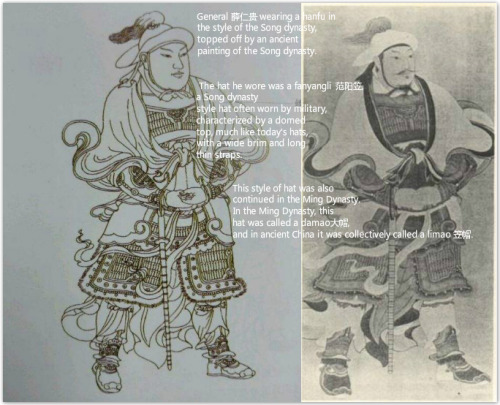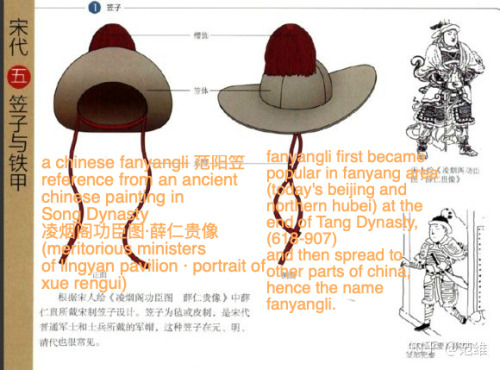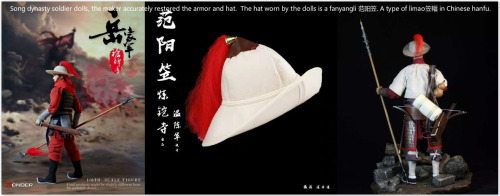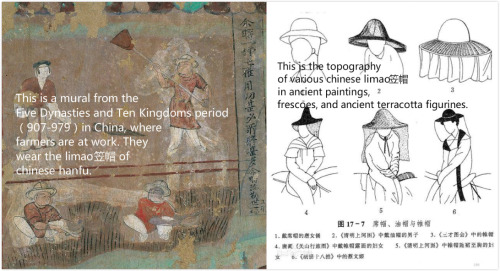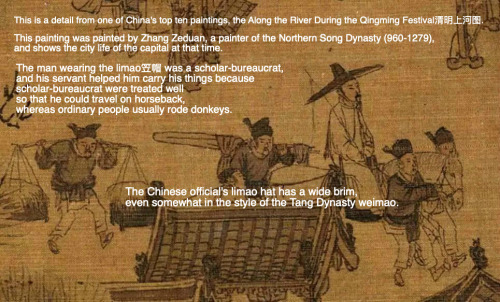hanfugallery:笠帽limao, a general term for a type of Chinese hanfu hat, characterized by a wide brim.
hanfugallery:笠帽limao, a general term for a type of Chinese hanfu hat, characterized by a wide brim. The primary form had already appeared during the Shang and Zhou dynasties( 1600 B.C.-256B.C.), and its invention was naturally related to shading from the sun and rain, with a large brim that could both block the rain and shade the sun. In ancient China, limao笠帽 were made of many materials, including bamboo baskets, pouches, ramie, yarn etc. The shape of limao笠帽 is with usually large brim, round, square or pointed tops. The later it was developed, the more it resembled today’s hats. In the Ming Dynasty this hat was called a damao大帽, yet it’s been around before Ming, inherited from the Song Dynasty and earlier dynasties.The picture below shows two limao unearthed from the tomb of the Yuan Dynasty minister Wang Shixian汪世显.Then let’s take a look at what the limao笠帽 looked like worn by Ming Dynasty soldiers.What about the damao大帽 worn by non-military officials and civilians in Ming dynasty?So how did the term of damao in Ming dynasty come about? The origin of damao is recorded in an ancient book of the Ming Dynasty, san cai tu hui《三才图会》(1607). This book is an encyclopedic book written by 王圻Wang Qi and his song 王思义Wang Siyi, who were literature scholars and book collectors during the Ming Dynasty. Here is the quote 《三才图会》:“大帽,尝见稗官云:国初高皇幸学,见诸生班烈日中,因赐遮荫帽,此其制也,今起家科贡者用之。” Generally when Zhu Yuanzhang, the first emperor of the Ming Dynasty, saw the students taking the imperial examinations sweating in the scorching sun, he gave them damao to protect them from the sun. The image below is a painting from the Tang dynasty, showing that the basic shape of the damao differs little from that of the Tang dynasty.The 平番得胜图ping fan de sheng tu is currently housed in the National Museum of China and is considered to be an accurate portrayal of the Ming dynasty’s army and is of high reference value.The above is the consistent history of limao笠帽 in Chinese hanfu. limao was a very common hat in all Chinese dynasties, worn by all classes. The basic shape with a high top made of black gauze and a knotted cord appeared early on. Of course, hats with brims is a common thing for every culture and are found in all parts of the world, just as Eastern and Western civilizations coincidentally documented the prehistoric Flood.For those interested in more specialized and complete information, here is a ten-minute video detailing the history of limao. To summarize, limao was first seen in the Han Dynasty terracotta figurines, called li笠, and documented in writings in the ancient book 急就篇(48b.c.-33b.c.), but the brim was not as big as it is now, in the Northern Dynasty(386-581), limao was inspired by the Xianbei people whose ancestors were nomads in ancient Siberia, so the brim was widened, and the top of the hat was added (recorded in the Northern Dynasty mural) and is almost the same as now, after the consistent development recorded but not limited to the Tang Dynasty terracotta figurines and Song Dynasty paintings, especially that Fanyangli influenced the limao style of the Yuan dynasty, and then the Yuan emperor Kublai Khan added curtains behind the limao, and beads and feathers according to the Mongolian custom, and then Ming emperors removed the curtains in the early Ming dynasty, forming a variety of styles. Facts about damao in Ming dynasty1. damao was influenced by limao of all the previous dynasties, and arose spontaneously. ✔️2. damao usually have round top, but there were also other forms of top, such as the quadrilateral.✔️2. In the early Ming dynasty, influenced by the Mongolian style of the Yuan dynasty (Mongolia added the beads according to its own nomadic style), damao used the gems or beads as a string. ✔️3. In the middle of the fifteenth century, Emperor Yingzong abolished the bead-string, stipulating that the damao could only be worn with plain string. ✔️4. The adornment of damao was mainly on the top, with jewels, feathers, and red tassels.✔️5. From ancient paintings, the decorative method of inserting feathers on one or both sides of the hat, is found in the Ming Dynasty and previous dynasties.✔️6. damao usually matches with wangjin网巾, a kind of mesh scarf tied back the bangs neatly. ✔️Now high-priced hanfu stores are making the damao exactly according to the Ming Dynasty style, and are considered historically accurate. However, some middle or low priced hanfu store are lazy and don’t make it accurately, so the details are confused with another country’ traditional hats with brim, or even worse. A few days ago a famous chinese artist accidentally used the picture of damao of that lazy store as reference to draw her super popular characters and post it on twitter, it could be controversial and offensive to some people from another culture who are not familiar with hanfu and lead to misunderstanding. And then she experienced cyberbullying which is really bad. (btw she also provides the correct ancient Ming portrait as a reference thoughI have cautiously observed, and must state that the damao she drew does not show a very clear feature that significantly different from the Ming dynasty damao of a traditional hat from another culture, and I think one reference picture of damao from taobao store does have a slight problem and is ambiguous. Incidentally, the non-damao hat that worn by the other character has also attracted criticism is no problem and actually called yishanguan翼善冠, one of the traditional types of hats for Chinese hanfu, which I will describe later.Well, you get the idea.In a more general sense, was the ancient Chinese costume culture, while retaining its original form, influenced by xiyu culture (a general reference to non-Chinese countries on the Silk Road, the ancient cultures of Western and Central Asia and the ancient states, xiyu西域 literally meaning western region) and nomadic cultures such as xianbei culture? Yes, especially in the Tang Dynasty. For example, yuanlingpao圆领袍/rongfu戎服.Did ancient China radiate its costume culture to its neighbors(not all of them), leaving behind similar or even convergent forms, while at the same time they developing their own local characteristics? Yes. If a culture had close contact with China in ancient times, but is geographically separated from China by a long distance or even by the sea, the later its identity will become stronger, and what used to look like Chinese clothing will become less obvious, such as the kimono. Here are examples of the basically accurate damao in style of ming dynasty by hanfu store. It does not contain all the types. -- source link
Tumblr Blog : hanfugallery.tumblr.com
#long post#stylish hats#history

